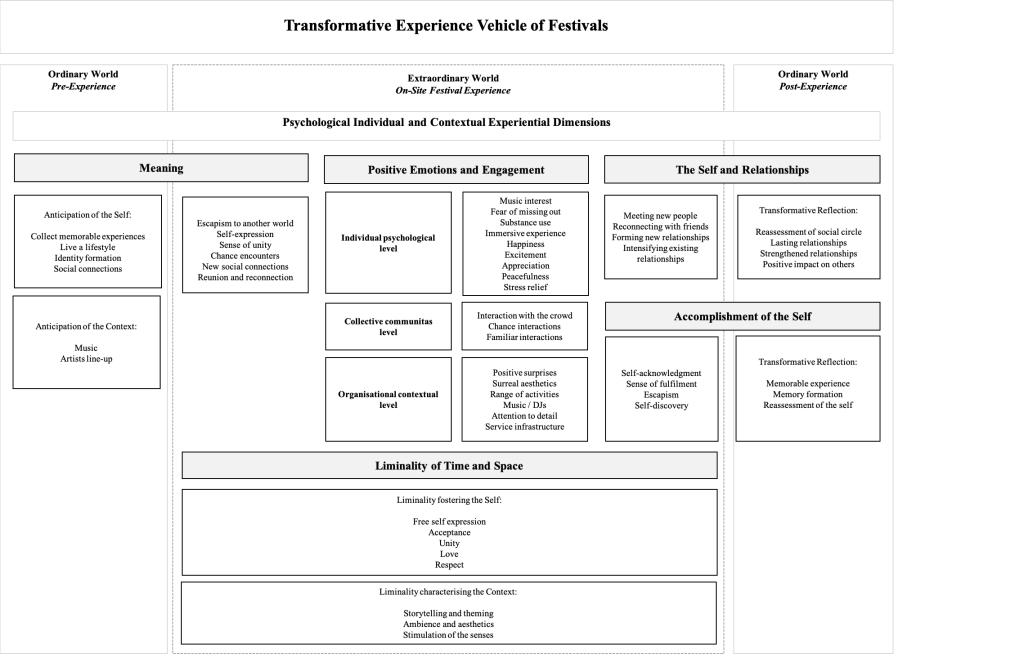When one thinks of festivals, usually religious or cultural ceremonies and celebrations may be the first ideas to come to mind. Nowadays, however, contemporary festivals, such as electronic dance festivals (EDM), are increasing in popularity, both as real-life events and within the domains of academic research. Viewing festivals as a
“human gathering offering an opportunity for personal exploration and development and [as a vessel] eliciting a positive psychological, psychosocial, and physical well-being impact on attendees”,
has allowed researchers to bridge the fields of tourism/hospitality and psychology in order to examine how human transformation and festival experiences go hand-in-hand. For instance, a recent study by Neuhofer, Celuch, and To (2020), described in this post, conducted 31 in-depth interviews with the aim of exploring the dimensions necessary for designing and providing transformative experiences at festivals by adopting positive psychology as a theoretical lens.
The transformation economy, positive psychology, & the role of experience design in human transformation
With a shift from the experience economy to the emerging transformation economy, consumers are becoming more and more interested in personal growth, a higher self, and life-transformative events (i.e. “once in a lifetime” events) rather than solely memorable experiences along with goods and services.
Tourists seek experiences that offer meaning, purpose, and self-fulfillment.
By emotionally triggering a person and stimulating peak moments of happiness and positive emotions, transformative experiences can leave a lasting impression and “interrupt” a person’s past vs. present self. In this way, in the context of tourism, travel and events can lead to a sudden shift in perspectives and positive lifestyle changes.
Here is when the subfield of positive psychology, led by the psychologist Martin Seligman, comes into play. It focuses on how humans thrive and flourish and which factors contribute to success and happiness. Five key dimensions leading to human fulfillment, also known as PERMA, have been established:
- positive emotions –> hedonic accounts of happiness; high emotional levels of valence
- engagement –> state of immersion in an activity; losing sense/track of time
- relationships –> the fact that humans are social beings; intimate interactions
- meaning –> ability to attach to something greater than oneself
- accomplishments –> extent of pursuing and mastering; higher self-esteem
By incorporating this theoretical framework into the fields of tourism and experience design, the extent to which positive, memorable, and transformative experiences occur can be studied as well as implemented for future events. Thus, referring to the latter,
intentionality is what sets designed tourism and hospitality experiences apart from natural and organic life events.
In these types of intentional experiences, individuals purposely leave their current life and ordinary environment behind and, rather, immerse themselves in a trip, musical event, or similar experience of the like. This is why experience design is considered an “intentional process for the creation of new services and experiences”.
However, in order for experiences to become “transformative vehicles” for human transformation to take place, a specific type of environment is required. In this case, the level of liminality and communitas plays a major role in event experiences. Liminality describes the transition to a sacred space and time that is distinctive from one’s daily life, while communitas refers to a group of people that are like-minded and share specific assets and features. Since these two elements are both highly present at musical (EDM) festivals, such as Tomorrowland or Burning Man, such grounds can be considered prime contexts for transformation to occur.
Human transformation at festival experiences – findings
Based on literature from positive psychology, PERMA, and experience design, 31 participants, who attended a festival in the past 12 months, took part in in-depth semi-structured interviews regarding EDM narratives, feelings, and emotions. Overall, the thematic analysis led to the development of a theoretical framework (Figure 1) in which “the model proposes that transformative experiences in temporal and spatial liminal settings are triggered by a series of psychological factors that occur within the individual and contextual factors that can be designed for in the environment”.

All in all, a transformation itself cannot be deliberately designed for; however, the dimensions and the intentional design of an environment, or “transformative vehicle”, offering a fertile and sacred place for human transformative to be induced, can indeed be positively created.
If you are interested in reading more about the framework and findings of this study, feel free to download the full article here:
To cite this article:
